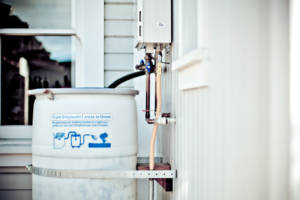
On Greywater Technology: A Murky Craft with a Bright Future
The average four person household pours over 38,000 gallons of reusable water down the drain each year, the bulk of which comes from bathrooms and laundries. Given the global concern over declining freshwater sources in drought-prone regions of the world, this mass disposal of water would lead even the least sustainable individual to inquire, “How can we repurpose this water?”
That’s when greywater technology becomes important. In the relationship between gardening and conservation, greywater recapture can play an integral role. With the implementation of proper plumbing material, we can reroute our “gently-used” water supply for use in irrigation, and in so doing, we can nourish our soil, water our fruit trees, and save on our water bills– all while allaying our collectively guilty conscience.
I was interested in implementing greywater technology in my own home environment, but doing so required getting more information on how recapture technology works. That’s when I heard about an ongoing campaign called The Water Effect, which was created by The Ecology Center in San Juan Capistrano. The campaign aims to bring sustainable solutions to high school students looking to enact a more sustainable lifestyle. In time, the center— which hosts courses on rain barrel installation, food preservation, how to make plant tinctures, garden design, and other courses for anyone interested in water conservation– became a valuable resource.
“How do you save water in your home?” our teacher Ty Teissere, an expert in holistic tree care, greywater education, and installation, asked. “Being vegan!” one man exclaimed. “Turning off the water while you’re brushing your teeth or putting soap on your hands,” added a lady next to me. “Wash your clothes by hand,” a returning veteran smiled.
“What about a reusable water bottle?” Teissere asked, suggesting that our energy consumption and overall footprint also impact our water consumption.
Before building our own laundry-to-landscape system, we dived into plumbing code and history:
In 1997, California State Plumbing Code announced the permitted use of multi-family, commercial, and institutional greywater use. Wastewater from washing machines, showers, baths, and sinks— which have fewer pathogens than blackwater, otherwise known as sewage— could officially be rerouted in order to preserve water expenditure via recapture and reuse. But there remained quite a bit of “Gray Area”, as each project required a permit for septic-like disposal, and the water that was being repurposed was often still viewed by some public health officials as blackwater (not fit for reuse).
Approximately 1.7 million un-permitted systems were installed in California alone, as a direct result of the ambiguous distinction between that which is defined as “grey” versus blackwater. This became a growing trend in states that aimed to emulate California’s plumbing code, such as Arizona, until the following year, in 1998, when Val Little, Director of Water Conservation Alliance of Southern Arizona, created a performance-based code outlining health and safety requirements. Those who followed this code and produced less than 400 gallons per day were officially legal. This opened the doors for experts to begin training programs, teaching sound methods of installation for the first time in history. Still, with these advancements, our research shows that six states have yet to define greywater, ten states (this includes New York) treat greywater as septic water, and 14 states define greywater as blackwater. The remaining states allow for residential irrigation only, and use a tiered approach for use– or they have embraced greywater irrigation wholeheartedly. Which is to say that much of the murkiness surrounding the discourse on greywater comes down to the everyday products (detergents, body wash, hand soap, dish soap, shampoo and conditioners, etc) that we invite into our lives and pour down our drains on a daily basis.
If we are uncomfortable giving gently-used water to our plants, flowers, and trees, then should we be ingesting these products through the body’s largest organ, our skin? “Each of you live in a watershed,” Teissere points out. “So use this greywater for your large annuals, large trees, shrubs, and bushes. Greywater systems are for apartments, large homes, and even your business. There is a huge industry growing with greywater and rain water capture simultaneously,” he told us.
To join the movement towards living in better harmony with our ecosystem, there are many ways to implement hands-on water saving techniques: installing a laundry to landscape irrigation system in exterior-walled laundry rooms, by using a branched drain system in the shower, by installing a kitchen sink branched drain or a pedal-powered washer, and much, much more. Most options are affordable (between $50 and $200), and can be retrofitted into existing drainage systems with the help of an experienced plumber (or a handy online guide– see below).
For more information on how to install greywater and rainwater recapture systems in your garden, visit Greywater Action’s “How To” Guide for implementing greywater systems at home.



































